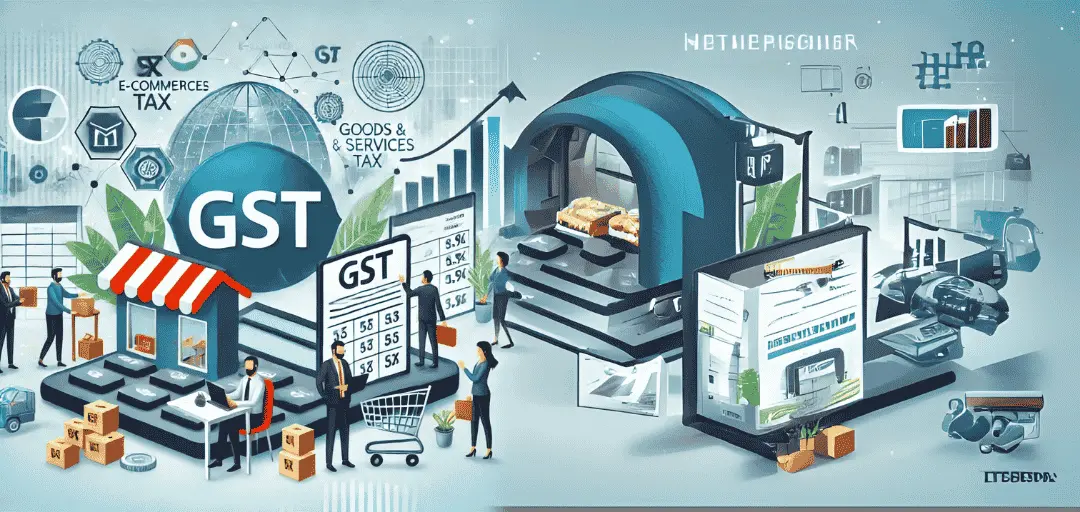GST on E-Commerce Businesses: What Sellers Must Know
The e-commerce industry has seen a significant boom in recent years, with more sellers leveraging online platforms to expand their businesses. However, taxation remains a crucial aspect of running an e-commerce business in India, and the GST on e-commerce is one of the key considerations for sellers. Understanding GST regulations, compliance requirements, and return filing procedures is essential to avoid penalties and ensure smooth business operations.
In this article, we will discuss everything e-commerce sellers need to know about GST on e-commerce, including registration, tax collection, compliance, and filing returns.
Understanding GST on E-Commerce
Goods and Services Tax (GST) is an indirect tax applicable to the sale of goods and services in India. It has replaced multiple indirect taxes such as VAT, service tax, and excise duty, streamlining the taxation system. Under GST, e-commerce businesses must comply with specific regulations different from traditional businesses.
1. GST Registration for E-Commerce Sellers
Unlike regular businesses, e-commerce sellers must register for GST irrespective of their turnover. As per GST laws, any seller or service provider using an e-commerce platform like Amazon, Flipkart, or Meesho must obtain GST registration before selling online.
2. Tax Collection at Source (TCS) under GST on E-Commerce
E-commerce operators (platforms like Amazon, Flipkart, Myntra) are required to collect Tax Collection at Source (TCS) at a rate of 1% (0.5% CGST + 0.5% SGST or 1% IGST) on the net value of taxable supplies made through their platform. The collected tax must be deposited with the government, and sellers can claim credit for it while filing their GST returns.
GST Compliance for E-Commerce Sellers
To ensure smooth business operations, sellers must adhere to various GST compliance requirements:
1. Issuing Tax Invoices
E-commerce sellers must issue GST-compliant invoices for every sale made through online platforms. The invoice should include details such as:
- Seller’s GSTIN
- Invoice number and date
- Description of goods or services
- HSN/SAC codes
- Applicable GST rate and tax amount
2. Filing GST Returns
Sellers must file monthly and annual GST returns based on their transactions. The key returns applicable under GST on e-commerce include:
- GSTR-1: Monthly/Quarterly return for outward supplies
- GSTR-3B: Monthly summary return
- GSTR-9: Annual return
- GSTR-8 (for e-commerce operators): Statement of TCS collected
Failing to file GST returns on time may lead to penalties and interest charges.
3. Input Tax Credit (ITC) for E-Commerce Sellers
Sellers can claim Input Tax Credit (ITC) on GST paid for purchases used in their business. However, ITC is only available if the supplier has uploaded invoices and paid the required tax. This makes it essential to maintain accurate records and verify supplier compliance.
Impact of GST on E-Commerce Sellers
While GST on e-commerce simplifies taxation, it also brings certain challenges for sellers:
1. Increased Compliance Requirements
Sellers must register for GST and file regular returns, which increases administrative work. The requirement to reconcile invoices and claim ITC adds to the complexity.
2. Higher Costs for Small Sellers
Small businesses that were previously exempt under VAT or service tax must now register under GST, increasing their tax burden and compliance costs.
3. TCS Deduction Affects Cash Flow
The TCS mechanism results in a temporary blockage of funds, impacting the cash flow of sellers, especially those operating on thin margins.
How E-Commerce Sellers Can Stay GST-Compliant
To navigate GST on e-commerce efficiently, sellers should:
✅ Ensure GST Registration – Register for GST before selling on e-commerce platforms.
✅ Maintain Proper Invoices – Issue GST-compliant invoices for all transactions.
✅ File Returns on Time – Avoid penalties by filing GSTR-1, GSTR-3B, and annual returns promptly.
✅ Claim ITC Properly – Keep track of purchase invoices and claim eligible input tax credit.
✅ Stay Updated on GST Rules – GST laws frequently change, so staying updated helps avoid compliance issues.
Conclusion
For e-commerce sellers, understanding and complying with GST on e-commerce is crucial for smooth business operations. Whether it’s registering under GST, filing returns, or managing TCS deductions, adhering to the regulations ensures legal compliance and avoids unnecessary penalties. By staying informed and organized, e-commerce businesses can efficiently handle GST requirements and focus on growing their sales.
Our GST Services

All E-commerce Tax services
E-commerce tax services help online sellers navigate GST registration, compliance, return filing, TCS management, tax planning, and audits, ensuring efficient tax management and legal compliance.

GST Filing
GST filing is the process of submitting tax returns to the government, detailing sales, purchases, and taxes paid or collected, ensuring compliance with GST laws.

GST Registration
GST registration is the process where businesses obtain a GSTIN from the government, allowing them to collect taxes, claim input tax credits, and comply with GST laws.





